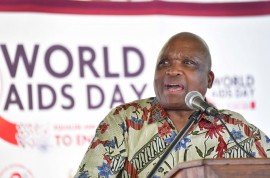
While South Africa has made significant inroads in the prevention and treatment of HIV and AIDS, Health Minister, Dr Joe Phaahla, has raised concerns about infections that continue to soar.
“Even though the country's HIV prevalence has remained stable at 13.5% over the last five years, the number of people living with HIV continues to rise every year as the country's population grows,” he said on Thursday.
“The path that our country has taken, as well as our contribution to the mission of achieving the objective of zero AIDS-related deaths, zero new infections, and zero prejudice, has been a difficult one.”
The Minister was speaking at the official commemoration of World AIDS Day at the Dr Petrus Molemela Stadium in Bloemfontein, in the Free State.
In 2021, KwaZulu-Natal, Mpumalanga and the Free State had the highest HIV prevalence rates at 18.3%, 15.9%, and 14.8%, respectively, while the Western Cape had the lowest at 8.3%, followed by the Northern Cape at 10%.
Research shows that the majority of the epidemic burden falls on Black Africans, who are more vulnerable and often excluded from accessing healthcare.
Meanwhile, the Minister applauded Free State for doing well in terms of testing, having already surpassed the 94% threshold.
Youth
Phaahla said government was working around the clock to address the alarming increase in the nation's youth, which continues to experience high rates of new HIV infections. “This is a critical issue if we are to stem the tide of rising HIV infections.”
Recent data revealed that new HIV infections in young people aged between 15 and 24, account for roughly 14 000 new infections in young males and 55 000 in young women.
“In light of these numbers, we need to keep working together across all sectors to raise awareness and improve our messages about prevention and sticking to treatment.”
Phaahla commended the South African National AIDS Council (SANAC) for launching the South African National Youth HIV Prevention Strategy in June 2022 as a three-year youth HIV prevention campaign.
The Minister believes that this is the key part of targeting young people, particularly adolescent girls, who are most vulnerable to new infections.
He said the goal of the campaign was to reduce the number of young South Africans who get HIV and other sexually transmitted diseases by 40%.
Phaahla urged Premiers, Mayors, and Councillors to play their part in the AIDS response and to work with all social partners.
“We can only meet our targets if we work side by side with civil society, development partners, traditional and Khoi-San leaders, traditional health practitioners, organised labour, and business,” he said.
“However, each of us must step up and be counted in the fight against the HIV epidemic, because while we may not all be infected, we are all affected.”
Progress
Phaahla reflected on the progress made as a country in the fight to eliminate AIDS as a public health threat by 2030, as set by Joint United Nations Programme on HIV/AIDS (UNAIDS).
He ensured citizens that government was committed to reversing the impact that the COVID-19 pandemic had on HIV prevention and treatment services.
In addition, government has put in place catch-up plans for HIV and TB so that services and care can be better integrated.
The new National Strategic Plan for 2023–2028 would place people and communities at the centre of the country's efforts to overcome inequities in the response to HIV and AIDS, sexually transmitted infections and TB.
“You may remember that in the past, someone close to you died from an AIDS-related disease every week and in every community. Those days are long gone and should never return.
“There have been many scientific advances in how HIV is treated, and we now know a lot more about the virus and how to treat it.”
He told the crowd that scientists are also hopeful about the benefits of treatment as a preventive measure and the progress being made toward ultimately finding a cure and a vaccine.
In addition, he announced that the country’s antiretroviral treatment programme has resulted in increased life expectancy and low rates of HIV transmission from mother to child, which is one of the greater successes in our response efforts to save lives.
“This means that millions of South Africans who previously had little chance of having a stable quality of life can now live longer and contribute to building the South Africa of our dreams.” – SAnews.gov.za


